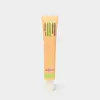What's inside
What's inside
 Key Ingredients
Key Ingredients

 Benefits
Benefits

 Concerns
Concerns

 Ingredients Side-by-side
Ingredients Side-by-side

Water
Skin ConditioningCoco-Caprylate/Caprate
EmollientC10-18 Triglycerides
EmollientDimethicone
EmollientHydrogenated Polyisobutene
EmollientAluminum Starch Octenylsuccinate
AbsorbentCetyl Alcohol
EmollientGlyceryl Stearate
EmollientNiacinamide
SmoothingMethylpropanediol
SolventAscorbic Acid
AntioxidantSodium Hyaluronate
HumectantHydrolyzed Hyaluronic Acid
HumectantSodium Acetylated Hyaluronate
HumectantMelaleuca Alternifolia Leaf Extract
PerfumingCeramide NP
Skin ConditioningCholesterol
EmollientStearic Acid
CleansingCaprylic/Capric Triglyceride
MaskingPhytosphingosine
Skin ConditioningOleic Acid
EmollientLactic Acid
BufferingHydrogenated Lecithin
EmulsifyingSorbitan Isostearate
EmulsifyingPolysorbate 60
EmulsifyingHydroxyethyl Acrylate/Sodium Acryloyldimethyl Taurate Copolymer
Emulsion StabilisingPEG-75 Stearate
Ceteth-20
CleansingSteareth-20
CleansingDimethiconol
EmollientCarrageenan
Sucrose
HumectantBetaine
HumectantAllantoin
Skin ConditioningTromethamine
Buffering1,2-Hexanediol
Skin ConditioningHydroxyacetophenone
AntioxidantCI 19140
Cosmetic ColorantWater, Coco-Caprylate/Caprate, C10-18 Triglycerides, Dimethicone, Hydrogenated Polyisobutene, Aluminum Starch Octenylsuccinate, Cetyl Alcohol, Glyceryl Stearate, Niacinamide, Methylpropanediol, Ascorbic Acid, Sodium Hyaluronate, Hydrolyzed Hyaluronic Acid, Sodium Acetylated Hyaluronate, Melaleuca Alternifolia Leaf Extract, Ceramide NP, Cholesterol, Stearic Acid, Caprylic/Capric Triglyceride, Phytosphingosine, Oleic Acid, Lactic Acid, Hydrogenated Lecithin, Sorbitan Isostearate, Polysorbate 60, Hydroxyethyl Acrylate/Sodium Acryloyldimethyl Taurate Copolymer, PEG-75 Stearate, Ceteth-20, Steareth-20, Dimethiconol, Carrageenan, Sucrose, Betaine, Allantoin, Tromethamine, 1,2-Hexanediol, Hydroxyacetophenone, CI 19140
Water
Skin ConditioningGlycerin
HumectantNiacinamide
SmoothingDistarch Phosphate
AbsorbentPropanediol
SolventOleic Acid
EmollientSclerotium Gum
Emulsion StabilisingSorbitan Olivate
EmulsifyingPunica Granatum Seed Oil
EmollientAscorbyl Palmitate
AntioxidantXylityl Sesquicaprylate
AntimicrobialCetearyl Olivate
Sodium Benzoate
MaskingDecyl Glucoside
CleansingLinoleic Acid
CleansingPotassium Sorbate
PreservativeBisabolol
MaskingLauryl Glucoside
CleansingTocopherol
AntioxidantHyaluronic Acid
HumectantAminomethyl Propanol
BufferingIron Oxides
Anhydroxylitol
HumectantAlgin
MaskingGlyceryl Undecylenate
EmollientTocopheryl Acetate
AntioxidantBentonite
AbsorbentGlyceryl Caprylate
EmollientCaffeine
Skin ConditioningMica
Cosmetic ColorantCI 77163
Cosmetic ColorantCaprylic/Capric Triglyceride
MaskingCalcium Citrate
BufferingCitric Acid
BufferingSodium Lauroyl Lactylate
EmulsifyingResveratrol
AntioxidantSodium Metabisulfite
AntioxidantWater, Glycerin, Niacinamide, Distarch Phosphate, Propanediol, Oleic Acid, Sclerotium Gum, Sorbitan Olivate, Punica Granatum Seed Oil, Ascorbyl Palmitate, Xylityl Sesquicaprylate, Cetearyl Olivate, Sodium Benzoate, Decyl Glucoside, Linoleic Acid, Potassium Sorbate, Bisabolol, Lauryl Glucoside, Tocopherol, Hyaluronic Acid, Aminomethyl Propanol, Iron Oxides, Anhydroxylitol, Algin, Glyceryl Undecylenate, Tocopheryl Acetate, Bentonite, Glyceryl Caprylate, Caffeine, Mica, CI 77163, Caprylic/Capric Triglyceride, Calcium Citrate, Citric Acid, Sodium Lauroyl Lactylate, Resveratrol, Sodium Metabisulfite
Ingredients Explained
These ingredients are found in both products.
Ingredients higher up in an ingredient list are typically present in a larger amount.
This ingredient is an emollient, solvent, and texture enhancer. It is considered a skin-softener by helping the skin prevent moisture loss.
It helps thicken a product's formula and makes it easier to spread by dissolving clumping compounds.
Caprylic Triglyceride is made by combining glycerin with coconut oil, forming a clear liquid.
While there is an assumption Caprylic Triglyceride can clog pores due to it being derived from coconut oil, there is no research supporting this.
Learn more about Caprylic/Capric TriglycerideNiacinamide is a multitasking form of vitamin B3 that strengthens the skin barrier, reduces pores and dark spots, regulates oil, and improves signs of aging.
And the best part? It's gentle and well-tolerated by most skin types, including sensitive and reactive skin.
You might have heard of "niacin flush", or the reddening of skin that causes itchiness. Niacinamide has not been found to cause this.
In very rare cases, some individuals may not be able to tolerate niacinamide at all or experience an allergic reaction to it.
If you are experiencing flaking, irritation, and dryness with this ingredient, be sure to double check all your products as this ingredient can be found in all categories of skincare.
When incorporating niacinamide into your routine, look out for concentration amounts. Typically, 5% niacinamide provides benefits such as fading dark spots. However, if you have sensitive skin, it is better to begin with a smaller concentration.
When you apply niacinamide to your skin, your body converts it into nicotinamide adenine dinucleotide (NAD). NAD is an essential coenzyme that is already found in your cells as "fuel" and powers countless biological processes.
In your skin, NAD helps repair cell damage, produce new healthy cells, support collagen production, strengthen the skin barrier, and fight environmental stressors (like UV and pollution).
Our natural NAD levels start to decline with age, leading to slower skin repair, visible aging, and a weaker skin barrier. By providing your skin niacinamide, you're recharging your skin's NAD levels. This leads to stronger, healthier, and younger looking skin.
Another name for vitamin B3 is nicotinamide. This vitamin is water-soluble and our bodies don't store it. We obtain Vitamin B3 from either food or skincare. Meat, fish, wheat, yeast, and leafy greens contain vitamin B3.
The type of niacinamide used in skincare is synthetically created.
Learn more about NiacinamideOleic Acid is an Omega-9 fatty acid. It can be found in many plant oils such as avocado and marula oils.
This ingredient is used to enhance the texture of products and as a cleansing agent.
Oleic Acid may not be fungal acne safe.
Learn more about Oleic AcidWater. It's the most common cosmetic ingredient of all. You'll usually see it at the top of ingredient lists, meaning that it makes up the largest part of the product.
So why is it so popular? Water most often acts as a solvent - this means that it helps dissolve other ingredients into the formulation.
You'll also recognize water as that liquid we all need to stay alive. If you see this, drink a glass of water. Stay hydrated!
Learn more about Water